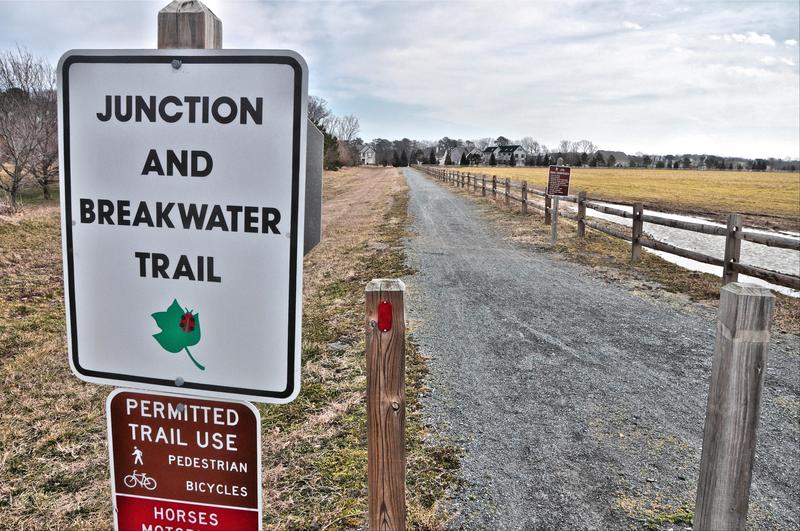There is good news for people who use Gills Neck Road and the Junction and Breakwater Trail to bike, walk or run into Lewes.
Safety concerns about the narrow road could soon be a thing of the past if a proposed Delaware Department of Transportation project comes to fruition.
DelDOT plans a new section of trail between the trailhead at Gills Neck Road, near the Hawkseye housing development, north into Lewes under the Freeman Highway bridge. At that point, the trail would connect to the proposed Georgetown-Lewes rail-trail.
The new section of trail – about 1.25 miles – would leave Gills Neck Road and pass through woods and fields in part of the proposed Showfield housing development. (See map for the proposed trail route.)
Engineering for the connector trail was expected to start this week, said Marco Boyce, DelDOT planning supervisor and landscape architect. Negotiations for the purchase of land and/or permanent easements for the new section of trail are ongoing. Boyce said if all goes as planned, construction on the trail extension could begin as early as this summer.
Unlike the rest of the Junction Breakwater Trail, the new section will not be part of Cape Henlopen State Park, said Susan Moerschel, chief planning manager for Delaware Department of Natural Resources and Environmental Control.
Junction and Breakwater Trail follows a section of the former Penn Central railroad between Lewes and Rehoboth Beach for approximately six miles. It is accessible from trailheads at Wolfe Glade parking lot on Wolfe Glade Road and Holland Glade parking lot behind Tanger Outlet Seaside. The first 3.6 miles of the trail in the Rehoboth Beach area opened in 2003 followed by another 2.4 miles of trail in 2007 to link Rehoboth Beach with Lewes.
Since then, as popularity of the trail grew, residents along Gills Neck Road began to complain about the number of bicyclists using the road, once they left the trail, to ride into Lewes. Although the trail has a connection from Hawkseye to Kings Highway in front of Cape Henlopen High School, most prefer the shorter route using Gills Neck Road, but that road is narrow with no trail or shoulders for bicyclists or pedestrians.
Moerschel said the proposed connecting trail would help eliminate safety problems. “There is no doubt it can be dangerous out there,” she said.
Trail boosts tourism as Cape Region link
The Junction and Breakwater trail has become an important connection point from Lewes to Rehoboth Beach. Used throughout the year by locals, it's become a tourist attraction for those wanting to get away from the traffic along the Route 1 corridor.
According to counters placed at three locations, the Junction and Breakwater Trail is one of the most used trails in the state. Although the count varies because of heavier use in summer, the monthly average trail user volume count is 4,350 at the trail's north end and 4,860 at the south end. Compare that to the busy James Hall Trail in Newark, which has a monthly trail user average volume count of about 5,300.
David Bartoo, DNREC trail planner, said the numbers can't be used to determine exactly how many people used the trail during a given month because there are too many variables. He said the counters record when a person passes by, whether it's once or several times in a day.
Betsy Reamer understands the benefits of the trail firsthand. Not only does she use the trail to commute to work, she also sees the tourism benefits of the trail as executive director of the Lewes Chamber of Commerce and Visitors Bureau.
Reamer says news of the new trail extension is exciting. “Compared to six to seven years ago, we've come a long way,” she said.
Reamer said it's not unusual for people on bicycles to stop by the chamber office asking for information or directions. It used to be the only bicyclists asking for help were those taking bikes across the Cape May-Lewes Ferry. “Now people know the trail exists, and they want information about it,” she said. “It's hard to trace the economic impact it has on Lewes, but I can't believe it doesn't have an impact. The trail brings people from Rehoboth Beach who might not otherwise be here, and the same holds true going the other way.”
Moerschel said an economic impact study on the trail is due out within the next two months.
More trail work due to take place in 2012
Marco Boyce, DelDOT planning supervisor, said planners are also looking at a trail extension at the southern end of the Junction and Breakwater Trail at Hebron Road in Rehoboth Beach. “We are looking for a better, off-road, route and trail into town to the Rehoboth Avenue bridge,” he said.
Planning for that section will begin this summer with construction at least two years away, he said.
DelDOT trail planners will begin engineering work this summer on the first phase of the proposed Georgetown to Lewes rail-trail for a section from the Lewes-Rehoboth Canal to Savannah Road.
Boyce said survey work would start soon. The process includes aerial surveys and more is visible without leaves on the trees. Any work on the first phase of the trail would take place in the spring of 2014.
The 17.8-mile trail would eventually link Georgetown with Cape Henlopen State Park.
In addition, DNREC planners are working toward a 1.1-mile extension of an existing trail to link Gordon's Pond with Herring Point within Cape Henlopen State Park to complete a 25-mile loop – using the Junction and Breakwater Trail, trails within the park and existing roadways – between Lewes and Rehoboth Beach.
The reason for all of the emphasis on trail work in 2012 can be tied to Senate Concurrent Resolution 13 signed by Gov. Jack Markell last July that calls on DelDOT to come before the Bond Bill Committee every year and demonstrate what it is doing to link the communities of the state with hiking and biking trails.
More than $7 million was put in the Bond Bill this year for work on the state's trails.




















































